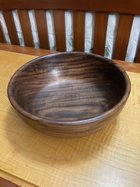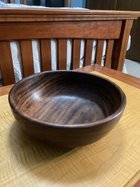I posted a question a week or so ago as a new turner asking about the compatibility of finishes with Yorkshire Grit. As was suggested, I wiped it down with mineral spirits. I then applied a 1:1:1 blend of tung oil, satin poly and mineral spirits before using a beall buff to apply wax. In the end, I'm pretty happy with how it turned out.
Constructive criticism is always welcome and appreciated.
Thanks,
John.
PS My photography skills are even more inferior than my turning skills
Constructive criticism is always welcome and appreciated.
Thanks,
John.
PS My photography skills are even more inferior than my turning skills



